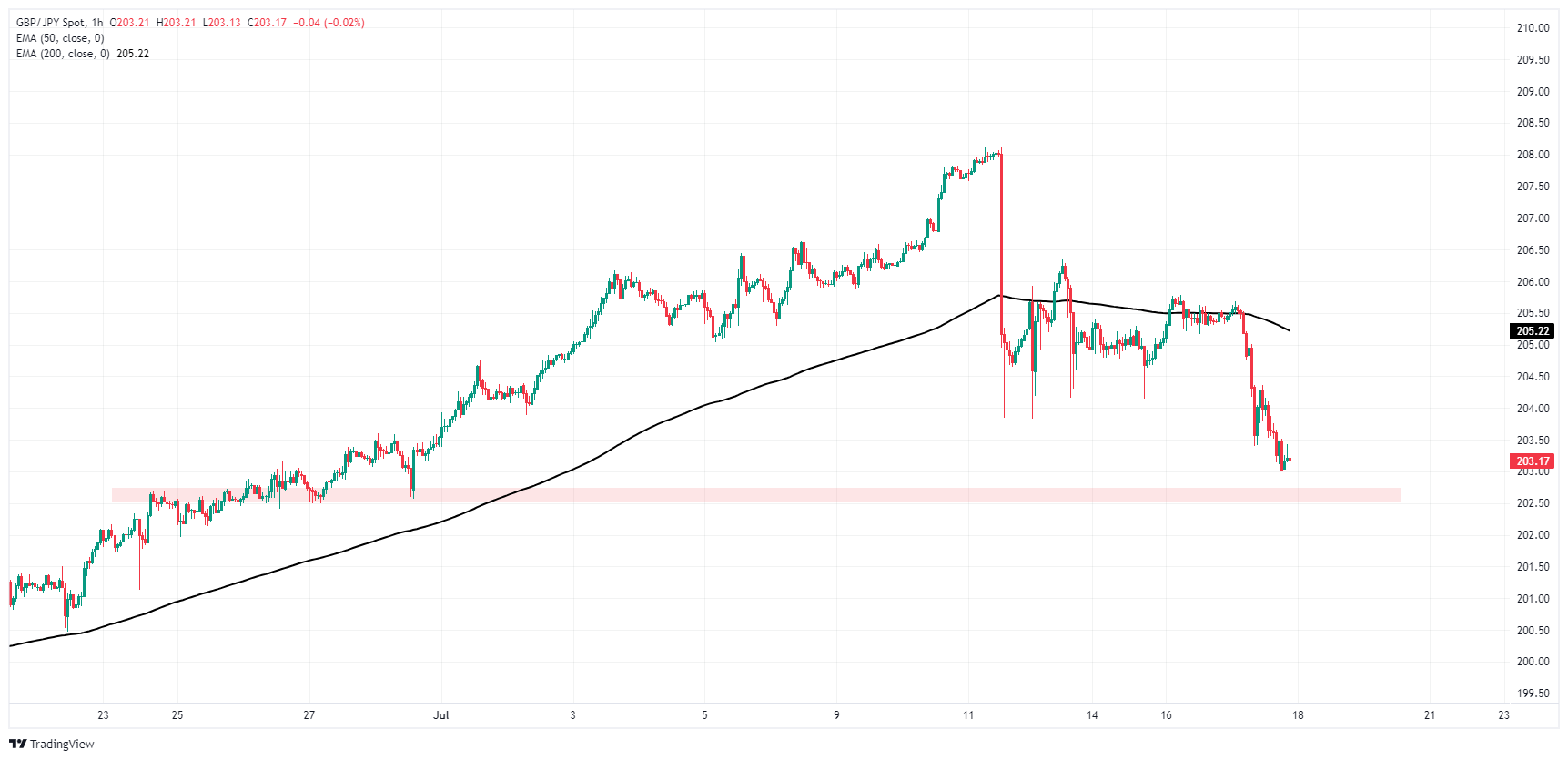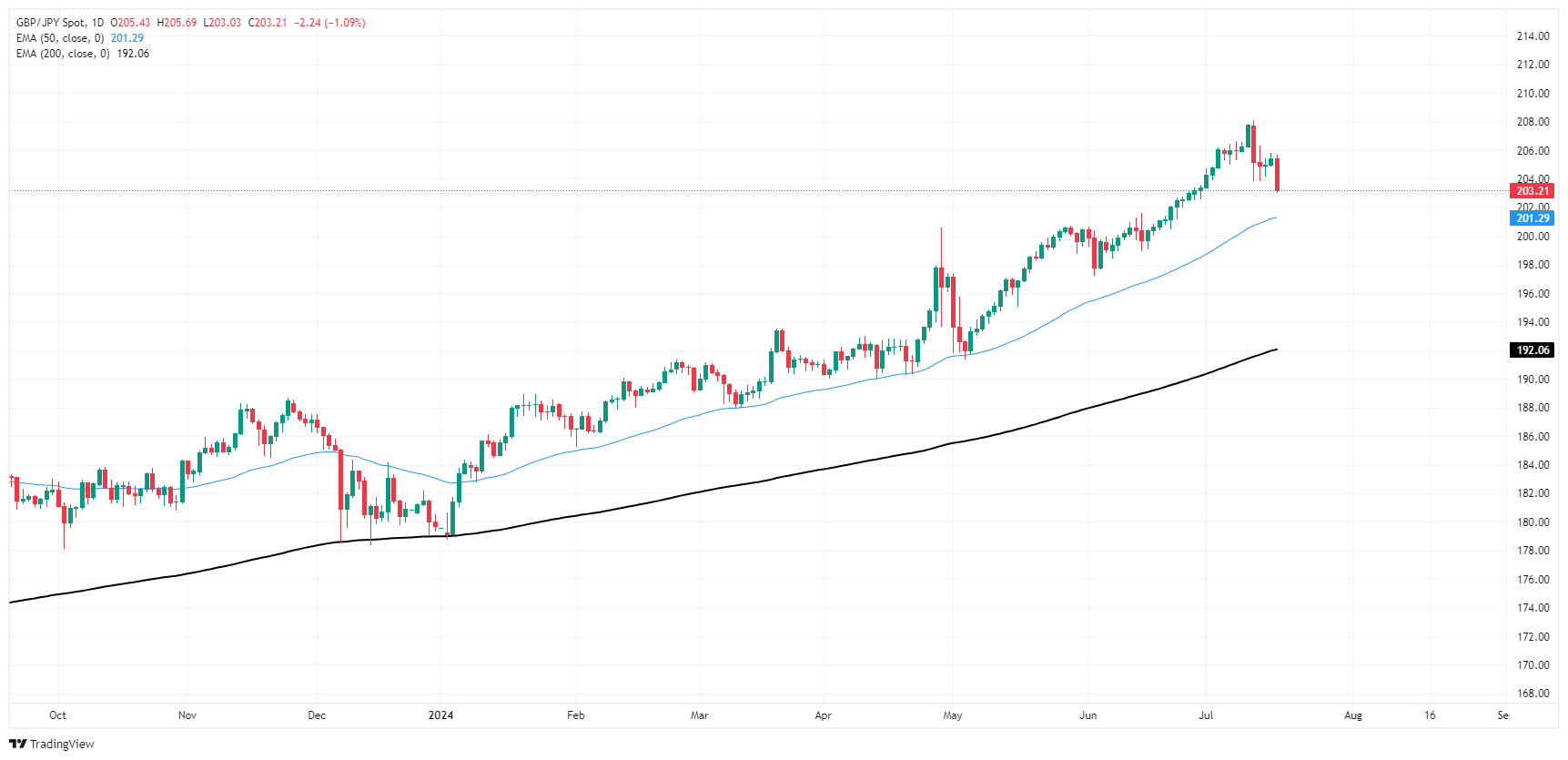- GBP/JPY tumbled back to 203.00 as markets suspect continued market intervention.
- The Yen soared a full percent against the Pound Sterling on Wednesday.
- This follows last week’s 2% sudden decline and a surge in BoJ spending.
GBP/JPY continued a pattern of sharp declines on Wednesday, tumbling over a full percent on the day as markets continue to suspect further direct intervention spending in an attempt to bolster the battered Yen.
According to reporting by Bloomberg, it is suspected that the Bank of Japan (BoJ) overspent on market operations to the tune of ¥2.14 trillion last Friday after week-on-week current account figures wildly overclocked money broker forecasts. No official statements from Japanese officials are expected, but if Wednesday’s extended downswing and last Friday’s Yen surge were a result of policymakers stepping into FX markets, it would represent the third and fourth instances of Yen defending just in 2024.
The Yen remains a deeply bearish currency that has become a sell-side favorite across the global fx markets. Even the Guppy’s -2.44% five day decline leaves GBP/JPY trading at 16-year highs, and direct market intervention is becoming increasingly expensive for Japan, a country with an already hefty debt ratio.
UK labor data, Japanese national CPI inflation numbers in the barrel
UK Producer Price Index (PPI) figures released early Wednesday did little to support the Pound Sterling with PPI inflation contracting 0.3% MoM in June, down from the previous revised 0.0% and entirely reversing direction on the forecast uptick to 0.1%.
UK labor data is in the barrel for Thursday, which is expected to show a sharp decline in unemployment claims. Claimant Count Change figures in June are forecast to ease to 23.4K from the previous 50.4K, and a misfire in the headline unemployment figure could shred further support for the GBP.
Japanese National Consumer Price Index (CPI) inflation is due on Friday, and while June’s annualized CPI inflation print is expected to tick up to 2.7% from the previous 2.5%, the figure is unlikely to be a strong enough inflation print to spark a topside move in interest rates from the BoJ. Japanese National CPI inflation figures are also forecast by Tokyo CPI inflation data which releases several weeks earlier, so market effects at the print tend to be muted.
GBP/JPY technical outlook
The Guppy tumbled back on Wednesday, falling toward the 203.00 handle amid broad-market strength in the Yen and flipping the pair into the red for the month of July, erasing the month’s gains and dragging bids down nearly 2.5% from July’s 16-year peak of 208.11.
A thin near-term consolidation range near 205.50 could provide an intraday technical support level for bids if they continue to circle the drain, but downside momentum still sees significant upside pressure. Daily candlesticks are still soaring well above the 200-day Exponential Moving Average (EMA) at 192.07, and bids would still need to drop another 0.8% before even coming within range of the 50-day EMA at 201.29.
GBP/JPY hourly chart
GBP/JPY daily chart
Japanese Yen FAQs
The Japanese Yen (JPY) is one of the world’s most traded currencies. Its value is broadly determined by the performance of the Japanese economy, but more specifically by the Bank of Japan’s policy, the differential between Japanese and US bond yields, or risk sentiment among traders, among other factors.
One of the Bank of Japan’s mandates is currency control, so its moves are key for the Yen. The BoJ has directly intervened in currency markets sometimes, generally to lower the value of the Yen, although it refrains from doing it often due to political concerns of its main trading partners. The current BoJ ultra-loose monetary policy, based on massive stimulus to the economy, has caused the Yen to depreciate against its main currency peers. This process has exacerbated more recently due to an increasing policy divergence between the Bank of Japan and other main central banks, which have opted to increase interest rates sharply to fight decades-high levels of inflation.
The BoJ’s stance of sticking to ultra-loose monetary policy has led to a widening policy divergence with other central banks, particularly with the US Federal Reserve. This supports a widening of the differential between the 10-year US and Japanese bonds, which favors the US Dollar against the Japanese Yen.
The Japanese Yen is often seen as a safe-haven investment. This means that in times of market stress, investors are more likely to put their money in the Japanese currency due to its supposed reliability and stability. Turbulent times are likely to strengthen the Yen’s value against other currencies seen as more risky to invest in.
Information on these pages contains forward-looking statements that involve risks and uncertainties. Markets and instruments profiled on this page are for informational purposes only and should not in any way come across as a recommendation to buy or sell in these assets. You should do your own thorough research before making any investment decisions. FXStreet does not in any way guarantee that this information is free from mistakes, errors, or material misstatements. It also does not guarantee that this information is of a timely nature. Investing in Open Markets involves a great deal of risk, including the loss of all or a portion of your investment, as well as emotional distress. All risks, losses and costs associated with investing, including total loss of principal, are your responsibility. The views and opinions expressed in this article are those of the authors and do not necessarily reflect the official policy or position of FXStreet nor its advertisers. The author will not be held responsible for information that is found at the end of links posted on this page.
If not otherwise explicitly mentioned in the body of the article, at the time of writing, the author has no position in any stock mentioned in this article and no business relationship with any company mentioned. The author has not received compensation for writing this article, other than from FXStreet.
FXStreet and the author do not provide personalized recommendations. The author makes no representations as to the accuracy, completeness, or suitability of this information. FXStreet and the author will not be liable for any errors, omissions or any losses, injuries or damages arising from this information and its display or use. Errors and omissions excepted.
The author and FXStreet are not registered investment advisors and nothing in this article is intended to be investment advice.
Recommended content
Editors’ Picks

Gold gives away some gains, slips back to $2,980
Gold retraced from its earlier all-time highs above the key $3,000 mark on Friday, finding a footing around $2,980 per troy ounce. Profit-taking, rising US yields, and a shift to a risk-on environment seem to be putting the brakes on further gains for the metal.

EUR/USD remains firm and near the 1.0900 barrier
EUR/USD is finding its footing and trading comfortably in positive territory as the week wraps up, shaking off two consecutive daily pullbacks and setting its sights back on the pivotal 1.0900 mark—and beyond.

GBP/USD remains depressed, treads water in the low-1.2900s
GBP/USD is holding steady in consolidation territory after Friday’s opening bell on Wall Street, hovering in the low-1.2900 range. This resilience comes despite disappointing UK data and persistent selling pressure on the USD.

Crypto Today: BNB, OKB, BGB tokens rally as BTC, Shiba Inu and Chainlink lead market rebound
Cryptocurrencies sector rose by 0.13% in early European trading on Friday, adding $352 million in aggregate valuation. With BNB, OKB and BGB attracting demand amid intense market volatility, the exchange-based native tokens sector added $1.9 billion.

Week ahead – Central banks in focus amid trade war turmoil
Fed decides on policy amid recession fears. Yen traders lock gaze on BoJ for hike signals. SNB seen cutting interest rates by another 25bps. BoE to stand pat after February’s dovish cut.

The Best brokers to trade EUR/USD
SPONSORED Discover the top brokers for trading EUR/USD in 2025. Our list features brokers with competitive spreads, fast execution, and powerful platforms. Whether you're a beginner or an expert, find the right partner to navigate the dynamic Forex market.